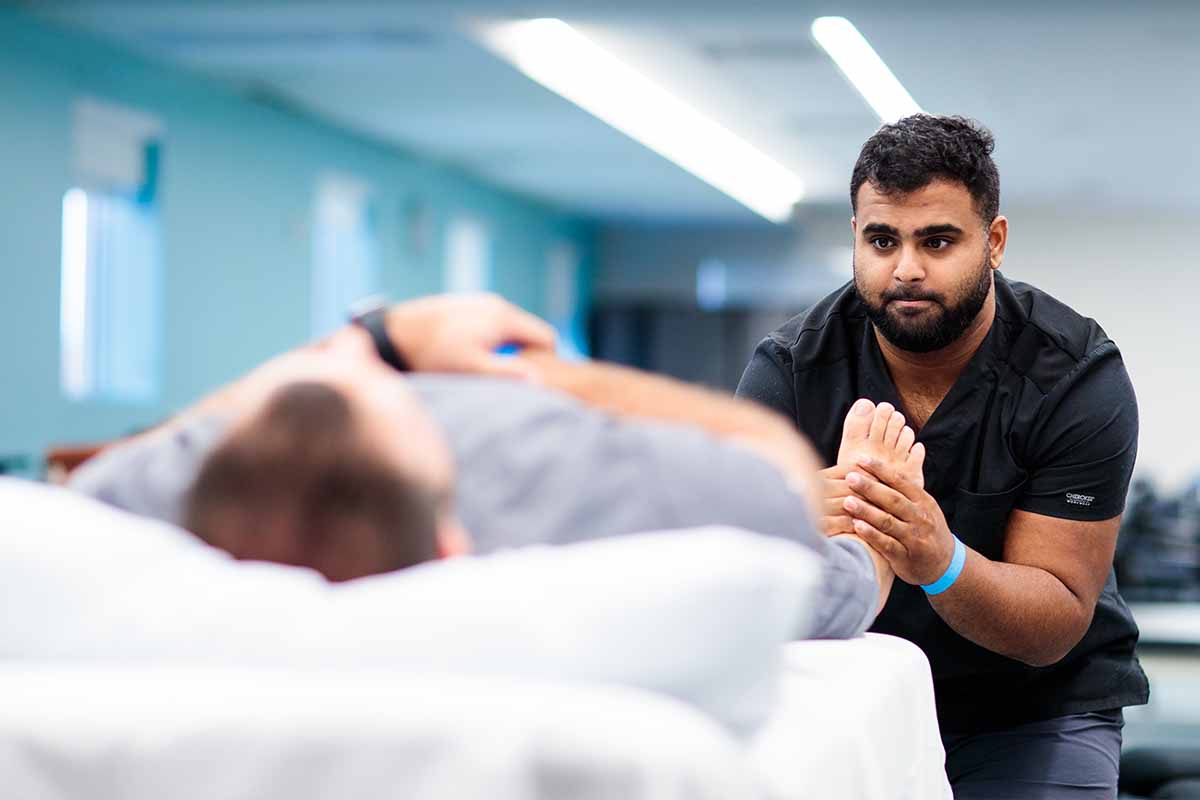
If you’re dreaming about helping patients restore their mobility and quality of life, and you’re exploring what it would take to become a physical therapist, you may be wondering, “Is a degree in physical therapy worth it?”
The answer to this question depends, of course, on your personal career goals. Some people choose to become physical therapist assistants because only a two-year associate degree is required. It’s true that pursuing a doctorate takes time and effort; however, there are countless advantages to earning a Doctor of Physical Therapy degree.
To that end, let’s look at some of the factors that make a Doctor in Physical Therapy (DPT) degree the best first step on an exceptional career path.
1. Physical Therapy Allows You to Make a Difference
Perhaps most importantly, a DPT degree will provide you with the opportunity to change lives. An average day as a PT in a clinic could involve moments like:
- Helping a senior patient walk for the first time in weeks
- Easing the chronic pain of a young athlete
- Seeing the smile on a child’s face as they kick a soccer ball again
In short, a licensed physical therapist helps patients of all ages and backgrounds. From preventative care to rehabilitation following an accident, the work of a physical therapist is undeniably valuable—and extremely rewarding, too.
2. Physical Therapy Has a Positive Job Outlook
When you’re investing time and money into a graduate degree program at a physical therapy school in Dallas, you want to know that you’re making the right move in the long term. With a DPT, your career outlook is overwhelmingly positive.
Salary
While the average physical therapist salary varies by geographical location and is subject to the variable costs of a physical therapy session, the median annual salary for a PT is $95,620. Even those in the bottom tenth percentile of the field—typically recent graduates—can earn a median salary of $61,930 per year.
If you’re already working in the field as a physical therapist aide or assistant (PTA), your salary after earning a Doctor of Physical Therapy degree will ultimately increase, given that you’ll most likely move into a PT role yourself. The median annual earnings for a PTA are only $49,180—just a little more than half of the median earnings of a physical therapist with a doctoral degree.
When you consider that the median annual earnings of U.S. workers in 2020 were $41,535, the salary of a DPT degree is relatively high.
A DPT also offers plenty of room for growth. If you take advantage of the physical therapy school in Austin or Dallas, or any accredited DPT schools in Texas and the advancement opportunities and practice for several years, you could find yourself among the top earners in the industry and make upwards of $127,110/year.
Demand
According to the U.S. Bureau of Labor Statistics (BLS), there is a growing demand for physical therapists. The Bureau expects PT employment to rise by 21% between 2020 and 2030—much faster than the average career.
This increase in demand could be attributed to various factors, including
- An aging population
- Greater promotion of health and wellness
- Shifts in the way we view preventative medicine
- Changes to healthcare policies and coverage
Regardless of the reasons, one fact is clear: PTs are needed in clinics, hospitals and other healthcare facilities in every state. According to the U.S. Bureau of Labor and Statistics, employment of physical therapists is projected to grow 15 percent from 2022 to 2032, much faster than the average for all occupations. About 13,900 openings for physical therapists are projected each year, on average, over the decade.
3. You Can Earn Your DPT in a Few Years
The entire process of physical therapy education—from graduating high school to walking out the doors of your university with a DPT—takes about seven years.
While earning your bachelor’s degree, it’s a good idea to choose one of the several relevant majors for physical therapy so you will have the right prerequisites in place when you begin researching graduate schools and submitting applications.
From there, you’ll enroll in a DPT program. While the time it takes to earn your degree varies, students typically complete it in around three years. For example, at the University of St. Augustine for Health Sciences (USAHS), the Residential DPT program is designed to be completed in 2.7 years.*
None of this is to say that pursuing physical therapy education will be effortless. Your mind will be put to the test as you master anatomy, biomechanics and PT technology tools.
But when you look at the length of time it takes to earn other degrees with similar post-graduation salaries, it’s no mystery why physical therapy is such a popular profession.
4. Physical Therapy Is an Exciting, Ever-Changing Field
Finally, physical therapy is a field in which strategies and technologies continue to evolve. While your goal of helping others will be the same each day, how you assist patients will rarely be the same.
One day, you could be applying electrical stimulation to a runner’s knee; the next, you might find yourself helping a stroke patient regain control of their facial muscles. Every day on the job presents a new challenge and a new opportunity to learn. And it’s gratifying to watch your patients improve!
*Time to completion may vary by student, depending on individual progress, credits transferred, and other factors. The Flex DPT program is designed to be completed in 4 years.
Doctor of Physical Therapy (DPT)
The largest PT school in the United States,** the University of St. Augustine for Health Sciences (USAHS) offers a hands-on Doctor of Physical Therapy (DPT) degree. Join a collaborative cohort of peers who learn under the mentorship of expert faculty-practitioners. Practice with mock and real patients in our state-of-the-art simulation centers and learn anatomy with our high-tech tools. Prepare for clinical practice with a wide range of patients, as well as for advanced roles in research, practice leadership and policymaking. Residential (blended didactic courses + in-person labs on weekdays) and Flex (online courses + in-person labs on weekends) formats are available.
**Based on total DPT degrees conferred, as reported by the Integrated Postsecondary Education Data System (IPEDS). Data is captured by IPEDS through interrelated surveys conducted annually by the U.S. Department of Education’s National Center for Education Statistics (NCES). https://nces.ed.gov/ipeds/
Doctor of Physical Therapy Candidacy Program (Launched Fall 2020) – Dallas Campus
| Effective April 28, 2020, the University of St. Augustine for Health Sciences’ Doctor of Physical Therapy program on the Dallas, Texas campus has been granted Candidate for Accreditation status by the Commission on Accreditation in Physical Therapy Education (CAPTE), 3030 Potomac Ave., Suite 100, Alexandria, VA, 22305-3085; phone: 703-706-3245; email: [email protected]). If needing to contact the program/institution directly, please call or email Dr. Thomas P. Werner at 469-498-5740 or [email protected]. Candidate for Accreditation is an accreditation status of affiliation with the Commission on Accreditation in Physical Therapy Education that indicates the program may matriculate students in technical/professional courses. Achievement of Candidate for Accreditation status does not assure that the program will be granted Initial Accreditation. |
Sources:
U.S. Bureau of Labor Statistics, Occupational Outlook Handbook, “Physical Therapists,” last modified April 18, 2022: https://www.bls.gov/ooh/healthcare/physical-therapists.htm.
U.S. Bureau of Labor Statistics, Occupational Outlook Handbook, “Physical Therapist Assistants and Aides,” last modified April 18, 2022: https://www.bls.gov/ooh/healthcare/physical-therapist-assistants-and-aides.htm.
Emily Shrider et al., “Income and Poverty in the United States: 2020,” United States Census Bureau, Sept. 14, 2021, https://www.census.gov/library/publications/2021/demo/p60-273.html.
U.S. Bureau of Labor Statistics, “Education pays,” last modified April 21, 2021: https://www.bls.gov/emp/chart-unemployment-earnings-education.htm.
U.S. Bureau of Labor Statistics, Occupational Outlook Handbook, “Physical Therapists: Pay,” last modified April 18, 2022: https://www.bls.gov/ooh/healthcare/physical-therapists.htm#tab-5.
U.S. Bureau of Labor Statistics. (n.d.). Physical therapists. Occupational Outlook Handbook: Healthcare Occupations. Retrieved from https://www.bls.gov/ooh/healthcare/physical-therapists.htm








